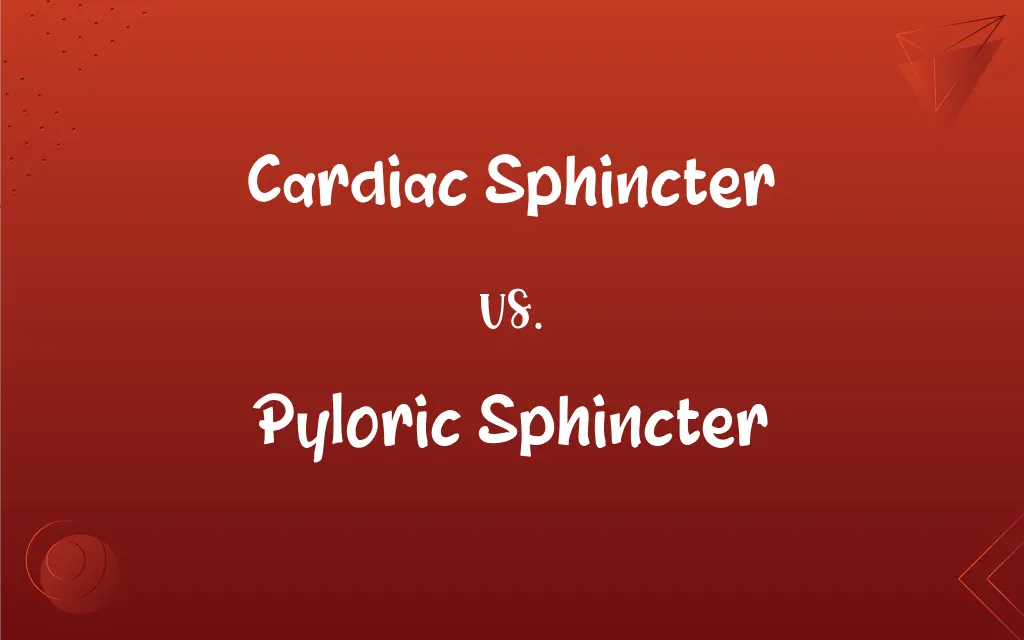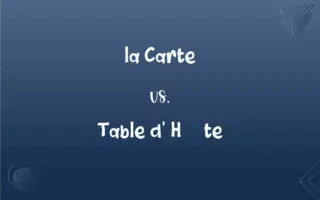Cardiac Sphincter vs. Pyloric Sphincter: What's the Difference?
Edited by Aimie Carlson || By Janet White || Published on August 12, 2024
The cardiac sphincter controls food entry into the stomach, while the pyloric sphincter regulates food exit from the stomach to the small intestine.

Key Differences
The cardiac sphincter, located at the junction of the esophagus and stomach, functions primarily to prevent acid reflux into the esophagus. In contrast, the pyloric sphincter, situated at the stomach's lower end, controls the passage of stomach contents into the small intestine.
Structurally, the cardiac sphincter is composed of muscles that constrict and relax to allow food into the stomach. The pyloric sphincter, on the other hand, is a muscular valve that opens periodically to permit digested food to enter the duodenum.
The cardiac sphincter's main role is to prevent the backflow of gastric contents, thus protecting the esophagus from stomach acid. The pyloric sphincter, however, plays a crucial role in digestion by timing the release of chyme into the small intestine for further digestion and absorption.
Disorders of the cardiac sphincter, like gastroesophageal reflux disease (GERD), can lead to heartburn and esophageal damage. Pyloric sphincter malfunctions, such as pyloric stenosis, can cause obstruction and hinder food movement from the stomach.
In terms of clinical significance, the cardiac sphincter is often a focus in treating acid reflux diseases. The pyloric sphincter, conversely, is central in conditions affecting gastric emptying and intestinal absorption.
ADVERTISEMENT
Comparison Chart
Location
Junction of esophagus and stomach
End of the stomach leading to the small intestine
Function
Prevents acid reflux into esophagus
Regulates food passage from stomach to small intestine
Structural Composition
Muscles that constrict and relax
Muscular valve
Role in Digestive Process
Protection against gastric acid backflow
Timing the release of digested food
Common Disorders
Gastroesophageal reflux disease (GERD)
Pyloric stenosis
ADVERTISEMENT
Clinical Focus
Treatment of acid reflux
Gastric emptying and intestinal absorption issues
Cardiac Sphincter and Pyloric Sphincter Definitions
Cardiac Sphincter
A muscular valve controlling food entry into the stomach.
The cardiac sphincter opens to allow food to pass from the esophagus into the stomach.
Pyloric Sphincter
A muscular valve regulating stomach emptying into the small intestine.
The pyloric sphincter controls the flow of digested food into the duodenum.
Cardiac Sphincter
Located at the esophagus-stomach junction.
The cardiac sphincter acts as a gatekeeper at the top of the stomach.
Pyloric Sphincter
Opens periodically to release chyme.
After stomach digestion, the pyloric sphincter releases the chyme into the intestine
Cardiac Sphincter
Opens during swallowing, closes to block gastric contents.
The cardiac sphincter closes tightly after food enters the stomach.
Pyloric Sphincter
Prevents backflow from the small intestine to the stomach.
The pyloric sphincter ensures one-way movement of food particles.
Cardiac Sphincter
Essential for protecting the esophagus from stomach acids.
The cardiac sphincter's effectiveness prevents esophageal irritation.
Pyloric Sphincter
Situated at the lower end of the stomach.
The pyloric sphincter acts as a gateway between the stomach and small intestine.
Cardiac Sphincter
Prevents acid reflux into the esophagus.
A malfunctioning cardiac sphincter can lead to heartburn.
Pyloric Sphincter
Plays a key role in digestion timing.
The pyloric sphincter's opening and closing is crucial for efficient digestion.
FAQs
What happens when the cardiac sphincter malfunctions?
It can allow stomach acid to flow back into the esophagus, causing heartburn.
What is the function of the pyloric sphincter?
It regulates the passage of food from the stomach to the small intestine.
Are there surgical treatments for cardiac sphincter issues?
Yes, procedures like fundoplication can help.
Can pyloric sphincter problems be treated?
Yes, conditions like pyloric stenosis often require surgical intervention.
Is the pyloric sphincter involved in nutrient absorption?
Indirectly, by controlling the release of food into the small intestine for absorption.
Where is the cardiac sphincter located?
At the junction of the esophagus and stomach.
Can a faulty cardiac sphincter cause health issues?
Yes, it can lead to acid reflux and GERD.
How does the cardiac sphincter protect the esophagus?
By preventing the backflow of stomach acids.
Can lifestyle changes impact cardiac sphincter health?
Yes, diet and habits like smoking can affect its function.
What is pyloric stenosis?
A condition where the pyloric sphincter is abnormally narrow, hindering food passage.
How does the cardiac sphincter respond to swallowing?
It opens to allow food into the stomach and then closes.
What role does the pyloric sphincter play in digestion?
It times the release of digested food into the small intestine.
Can babies have issues with the cardiac sphincter?
Yes, infants can experience reflux due to an immature cardiac sphincter.
Does the pyloric sphincter have a role in preventing ulcers?
Indirectly, by controlling stomach emptying, it can influence ulcer development.
Is the pyloric sphincter's function affected by diet?
Diet can influence its functioning, particularly in digestion timing.
What is gastroesophageal reflux disease (GERD)?
A condition often related to cardiac sphincter dysfunction, causing acid reflux.
Are there tests to assess pyloric sphincter function?
Yes, tests like an ultrasound can assess its function.
Can medications treat cardiac sphincter issues?
Medications can help manage symptoms like acid reflux.
What factors can weaken the pyloric sphincter?
Factors like surgery, certain medications, and diseases can affect its strength.
What symptoms indicate a pyloric sphincter malfunction?
Symptoms like vomiting and abdominal pain can indicate issues.
About Author
Written by
Janet WhiteJanet White has been an esteemed writer and blogger for Difference Wiki. Holding a Master's degree in Science and Medical Journalism from the prestigious Boston University, she has consistently demonstrated her expertise and passion for her field. When she's not immersed in her work, Janet relishes her time exercising, delving into a good book, and cherishing moments with friends and family.
Edited by
Aimie CarlsonAimie Carlson, holding a master's degree in English literature, is a fervent English language enthusiast. She lends her writing talents to Difference Wiki, a prominent website that specializes in comparisons, offering readers insightful analyses that both captivate and inform.






































































